A recent article on Dailyserving.com by Catherine Wagley (also an Art21 blog columnist) discussed methodology — the artist’s bread and butter. Catherine states that “figuring out how to put objects and stories out into the world without imposing yourself on your audience is a perpetual problem artists will indefinitely grapple with. But having a methodology, like a having a diet and a bedtime, allows you to keep making work as you keep living, in spite of the unanswered questions. It’s an old trick, using method to combat uncertainty—still, it’s the most stalwart, honest fail-safe, and it doesn’t stifle the questioning; it just keeps the work coming.”
My last blog post for Open Enrollment went through the ABC’s of graduate art student insecurities and fears. I have moved forward from many of these paralyzing thoughts, but as a first year in grad school, I am still learning the things I need to get the most out of my time in the studio. I’ve found that having the ingredients for making readily available is half the battle. In my case, this means having plenty of fabric around and some quality tunes on the stereo. But what then? Sometimes even Joni Mitchell can’t get me out of my rut. So I decided to turn to some of my peers who are in their second year in the program (each from a different department at Cranbrook) who have put in the hard time to cultivate a personal methodology. Ian Jones from Print Media, Anne Vieux from Painting, Will Connally from Photography and Mackenzie Schubert from 2D Design joined me around my living room table to have a beer and talk shop.
Part I: Method
Ian Jones [ianmicheljones.com]
Lindsay Preston Zappas: How are you using method to combat uncertainty in the studio?
Ian Jones: The most consistent is my sketchbook practice. Especially if I’m getting jammed up, I can always have a mobile mini studio by my side.
Will Connally: I keep a sketchbook in my bag too. In my studio I’m working on drawings and paintings, but a lot of times, I’m brainstorming elsewhere. I take really long showers…I have a pen that’s waterproof, so I do a lot of brainstorming in the shower, and taking walks. But then I feel guilty, so I’ll go make an appearance and sit at my desk in the studio for a minute, and then go off again.
Anne Vieux: Cleaning out my studio and looking at my materials helps to really figure out what I want to work with. Usually, I just listen to some dreamy music and piddle around. I also learn the most from photos of my work. Looking back through photos of my studio is kinda of like a sketchbook for me. I used to sketch a lot more, but I have a hard time committing to a blank page. I always think, ”this piece of paper is so nice.”
LPZ: Ian, you mentioned earlier that you take on roles in the studio (carpenter, tailor, cartographer, and journalist).
IJ: Yeah, it comes from the notion of the method actor, where the character you are playing has no separation from yourself. So each role has a metaphor or a metonym to it. I try to understand the category that each of my ideas takes, and then approach the making from the vantage point of each role. It’s just a way that I can work through ideas without being too literal or linear with any of it.
LPZ: But it provides you with a framework or some rules to work under.
IJ: Right. It’s a way to tie together my interests: I want to make drawings, I want to make things with fabric and with wood, and I want to reference the autobiographical through the journalist. I think of journalism similar to that of Hunter S. Thomson; gonzo journalism.
Anne Vieux [annevieux.com]
AV: I do the same thing, in giving myself different references to work between in my studio. So, little frameworks of things you can draw on and work between help me work freely and find intuition. I think it helps me to know that in the end it will always mean something if it came from this process.
Mackenzie Schubert: I work almost exactly oppositely. A lot of what I’m doing is building discrete objects that are their own things, and then when it comes to a critical component, I’m pulling them out. I’m very interested in the syntax, in the way these things sit together – these things that I built discretely. So, I’m building a library and then putting them together.
LPZ: I like what you said Mac when we talked earlier that “everything I am making is either research or practice.”
MS: I treat my studio like a sketchbook. I’m working on a bunch of things, and trying to realize them fully, but I’m always thinking “Oh, this isn’t the actual thing.” I think about it as lying to myself, and a way to always keep something on the horizon. It’s a little more fluid for me to stagger the work that way, and I don’t get as stuck in a planning stage.
LPZ: Going back to the fear of the blank page, Ernest Hemingway said the most frightening thing he ever saw was a blank sheet of paper. He would finish the day literally in the middle of a sentence so he would have somewhere to start the next day. I think that staggering is a really useful tactic in the studio.
Part II: Manic Transcendence
Mackenzie Schubert [mackenzieschubert.blogspot.com]
LPZ: Is there a way that you structure your time in studio to be most productive?
IJ: I try to spend as much time physically in the studio as possible. But I feel like it always comes back to the sketchbooks. It’s practice. As long as your doing that, something will come out of it. I mean we all freak out, but it’s just about getting through those weird hyperventilating moments. You can’t put qualifiers on it – like when can we say “man I really transcended the work today.” How often does that happen? But you just go in and work everyday.
MS: I think I’ve given up on transcending.
LPZ: I guess then it’s about coming to terms with the manic nature of working in the studio; some days I feel great about my work, and other days are just tormenting. Does it get easier to be okay with that?
MS: I feel like I go through those cycles even throughout one day. I’ll get up in the morning and have a couple cups of coffee, I feel great, I’m ready to go, and then after lunch when the hyperactivity wears off, I have to remember that I felt good about things this morning. In those times, I have to to trust something I felt earlier, and just execute the idea.
AV: Sometimes, I have to be up at 7 AM and get to the studio by 8. I really love the silence between the hours of 8 and 1 when the studios are quiet and there is a lot of privacy. I get so much work done. But you also have to acknowledge the times when you can sense your mind is not going to work that way, and be sensitive to that. Sometimes I just need to lay in bed and apply for opportunities or edit images, and give my brain some time to rest. It really comes down to ritual. You have to have your own rituals and know yourself.
IJ: There is a Zen Buddhism idea called “the beginner’s mind.” Basically, it’s about releasing any preconceived notions you might have for something, so that way you would always have an interest and a thirst for what you were doing. I think about that when working on something that’s painfully laborious: shifting your perspective of what something is and how you can understand it in a different light.
William Connally [williamconnally.com]
MS: Back home I would go backpacking a lot, and I would have the best time when things were just the shittiest; like when it was raining and you’re miserable, you just become so aware of the situation. I am always trying to apply that when I’m in a bad place while making something; it’s about realizing that the awful part of a project is actually a really good part.
IJ: A friend last year told me, “You will go broke trying to see what you see.”
LPZ: There’s an Ira Glass interview where he talks about taste. He describes, how all of us that get into creative work get into it because we have good taste, but for many years there is a gap where your “killer taste” and your output aren’t matching up. The most important thing he says is just to do a lot of work, and make a deadline. It’s only through going through a volume of work that the work your making will be as good as your ambitions.
[youtube:https://www.youtube.com/watch?v=BI23U7U2aUY]
Part III: Secret Weapons and Security Blankets
LPZ: Do you have any secret weapons in the studio? It could be looked at as secret weapon or security blanket. Are those the same thing?
MS: It’s terrifying to think of them as the same thing, but they probably are.
WC: I find myself falling back to cheap paintings on cardboard. Growing up my mom was a puppeteer and my dad did theatre. It started when I was making a photo and I couldn’t find an object from the right time period. I was pissed off, and I painted it on cardboard and just stuck it in the shot. It worked, so then I just started making more and hiding them in my photos.
AV: Black lights. They have a lot of effect with minimal effort.
IJ: Music. Some of the music I listen to is dated, but I try to carry that emotion into the work. I’ve been listening to Waylon Jennings because it gets me in the right head space to deal with something. That goes along with the roles we were talking about, I sometimes try to think about what music a certain persona would listen to and go for that. It puts you into an altered state, where you can just noodle on something.
AV: It’s funny to think about playing a character in your studio. It’s like who you imagine yourself to be as an artist.
MS: I was just reading about Daniel Day Lewis (via Wikipedia), who’s a big method actor. He finished a big movie and just said ‘you know what? I’m going to go be a cobbler in Italy for three years.’ The moments when I flip and do something completely different have been where I make the biggest amounts of progress; switching your entire mindset vs. just adjusting your sliders a hair at a time.
*****
Somewhere between character-acting, taking long showers, and listening to music the magic happens; it seems there is more than one way to skin a cat when it comes to studio method. During our conversation, we talked about “transcendence” in a tongue-and-cheek sort of way, but I think secretly it is really what we are all after. I’m not talking earth shattering revelations here, rather the simple kind of transcendence that happens when two materials come together in a way that seems so good that it’s beyond yourself. I think Anne put it well when she said at the end of the day it comes down to ritual, and knowing yourself. And, hey, there’s always tomorrow.

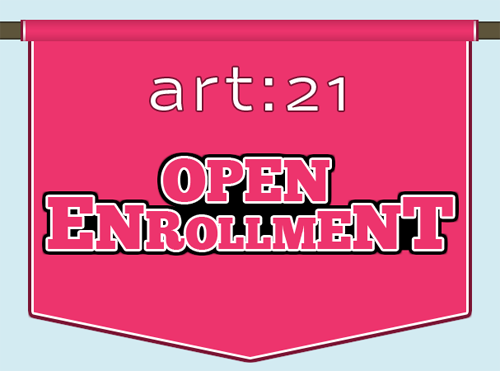

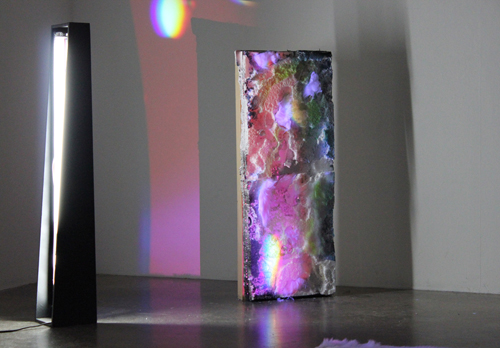
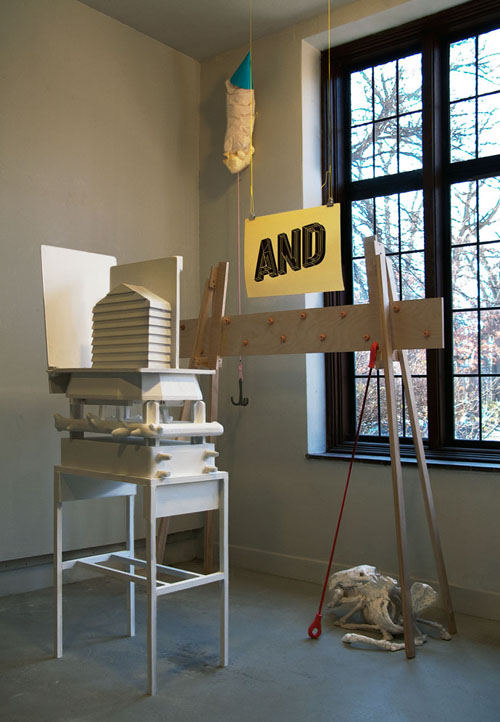
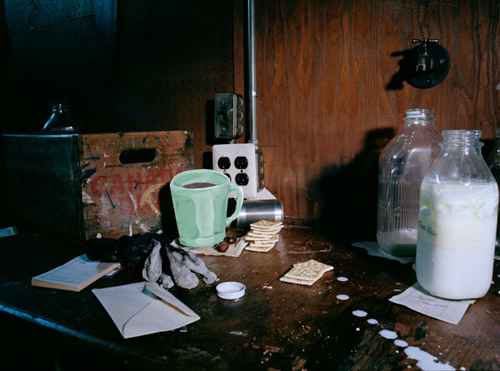
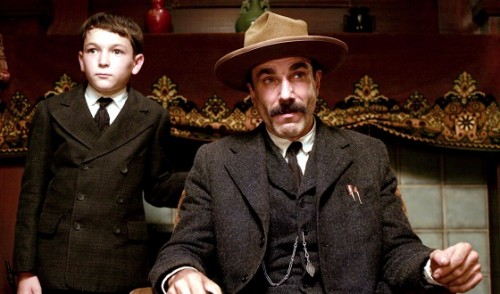



Pingback: Art21 Blog Interview | William Connally Photography